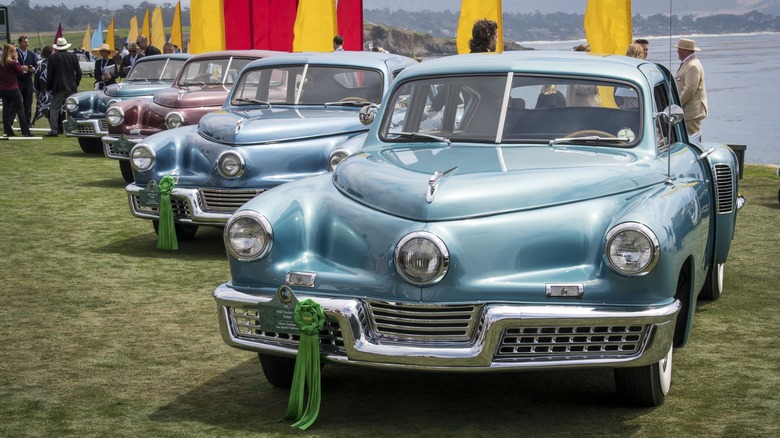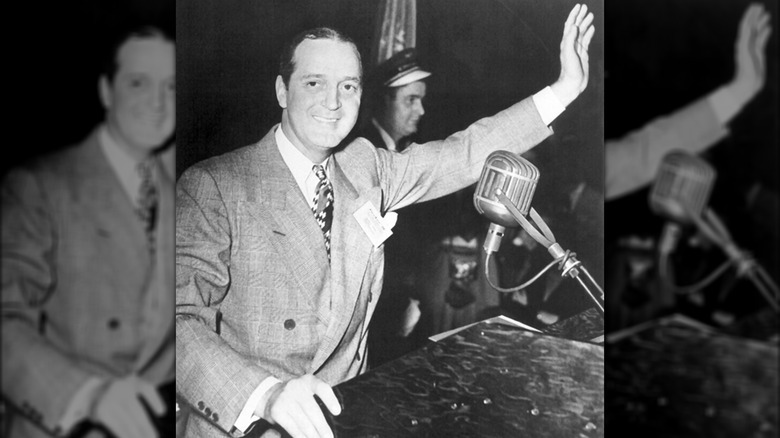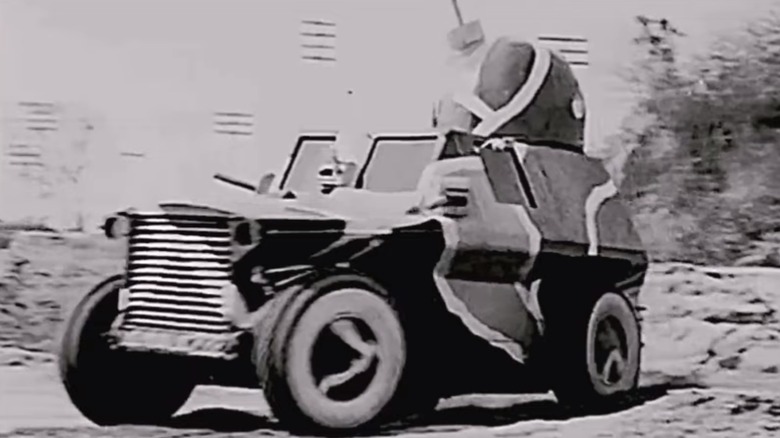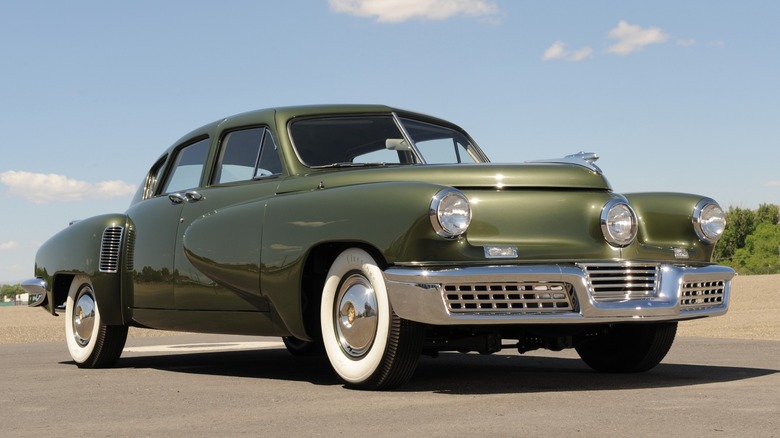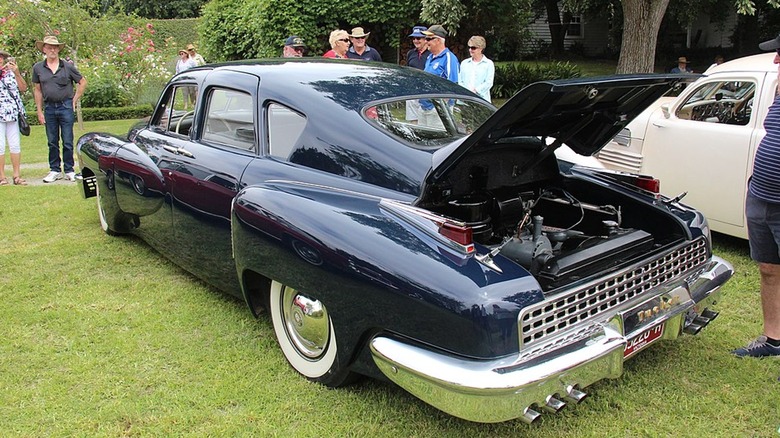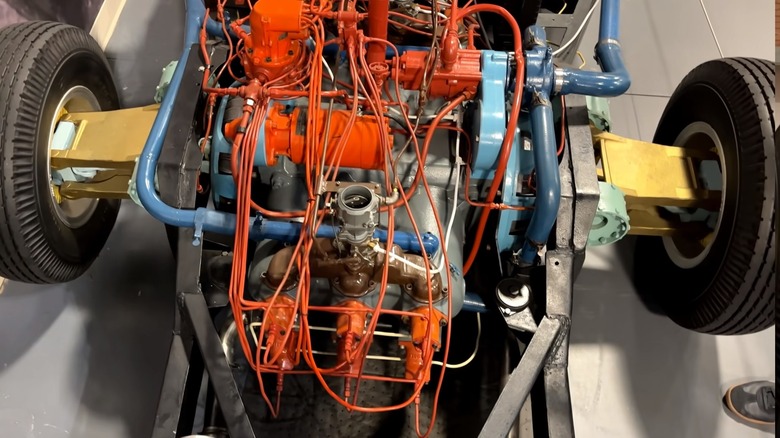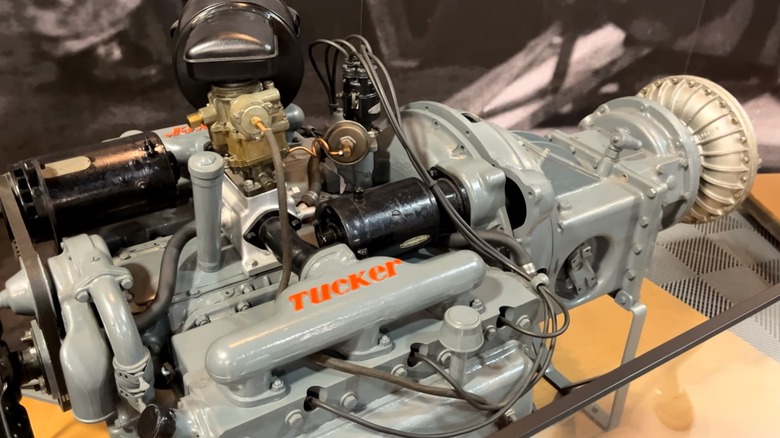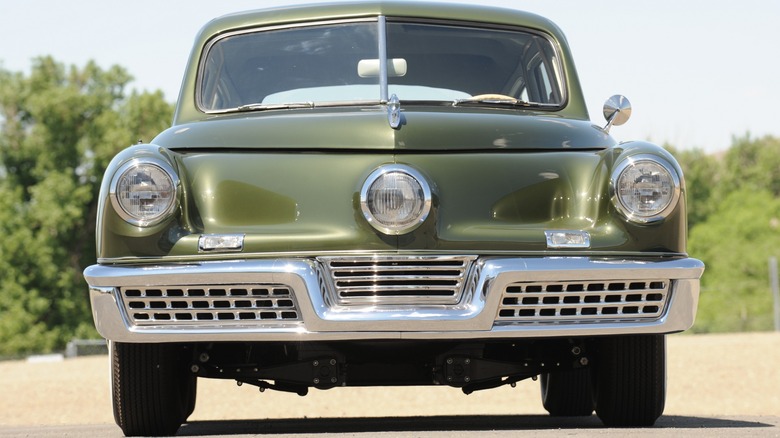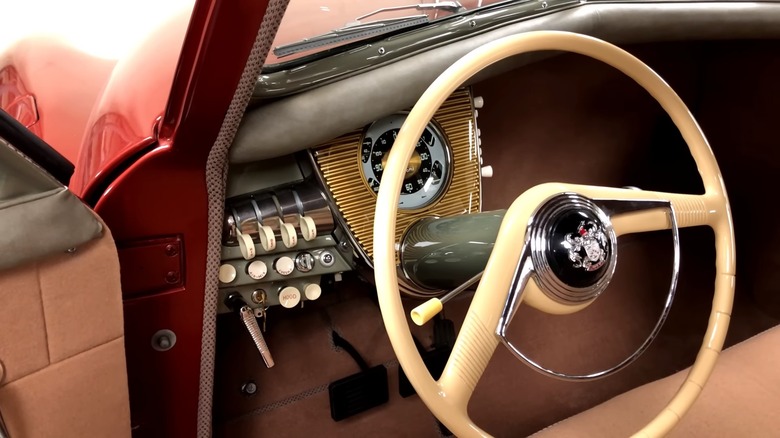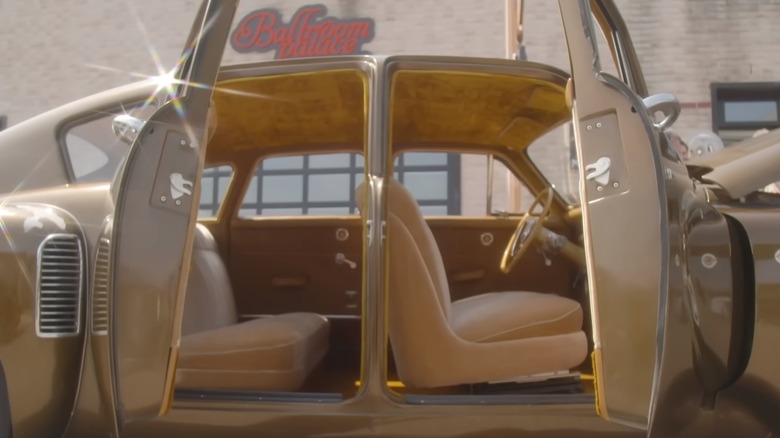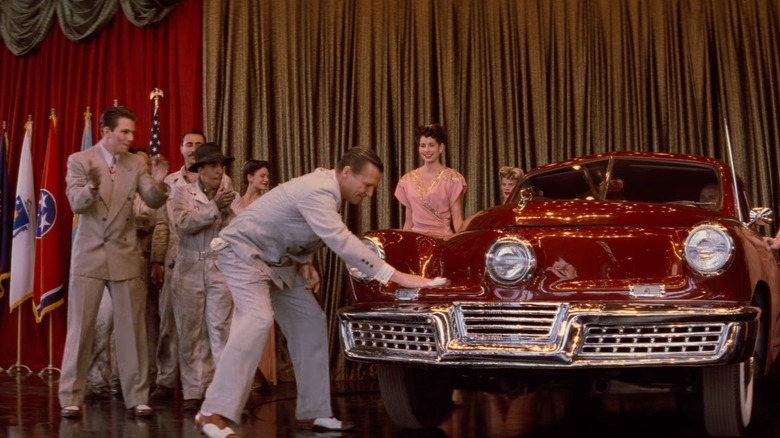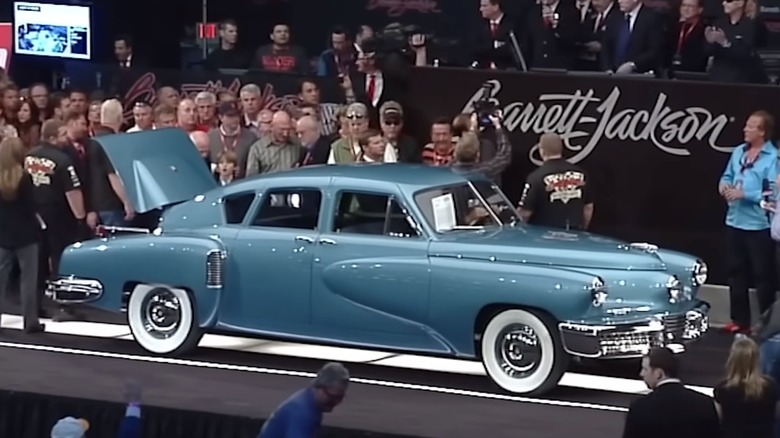Everything Classic Car Fans Should Know About The Tucker 48
Many times in the post-war era, a visionary carmaker has come along with plans to offer a car so unique and innovative that no legacy automaker could offer anything like it. The DeLorean Motor Company comes to mind as one of these projects that ended in disaster but left us with a phenomenal machine. Tesla could have easily become just another story but managed to beat the odds. But before both of those brands rolled into our collective consciousness, there was the Tucker Corporation and its cutting-edge Tucker 48 sedan.
The brainchild of Michigander Preston Tucker, the Tucker 48 was to become the car of the future, offering features nobody had thought of with the style, class, and quality everyone wanted. It was an upstart company looking to get in on the frenzied redevelopment boom of the years immediately following WWII, an era deprived of new car models while the nation's industries were occupied with turning out equipment to send "over there." Coming out of the war, the United States was in the best position globally to unleash its industry on a waiting consumer class with an abundance of pent-up demand.
Sadly, longevity would not come to the Tucker Corporation as the project ended in failure. What it did leave us with is a fascinating story and 51 captivating sedans. The Tucker 48 embodies the spirit of hope of the post-war era, and if you are a classic car fan, here is everything you should know about it.
Preston Tucker
For a child growing up in Michigan in the early 20th century, working in the automobile industry probably seemed only natural. Preston Thomas Tucker, born in 1903 in Capac, Michigan, began working in the Cadillac offices of General Motors at just 13 years old. As he entered his 20s, Tucker bounced around a few jobs until he discovered his natural talent for sales, excelling at moving Studebakers and Chryslers and raising his profile enough to become a zone manager for Pierce-Arrow.
Tucker's sales experience led him to develop an entrepreneurial spirit, establishing a few businesses before building a car company. With a partner who had been instrumental in the early success of the Indianapolis Motor Speedway, Tucker persuaded Henry Ford to sponsor a racing team with 10 advanced design cars to race in 1935. Ford's initial capital expenditure of $25,000 soon turned into $117,000, only to have just four cars qualify and none of them finish the race. The experience soured Ford so much that he swore off racing sponsorship for good.
Tucker had a machine shop behind his home in Michigan and he used it to contribute to the war effort in the early '40s. But as the war appeared to be nearing an end, he set his sights on building a new automobile, establishing the Tucker Corporation in July 1946 despite having little experience managing an auto manufacturer or being an industrialist. Furthermore, Tucker was not a wealthy individual, meaning any new business venture would require someone else's money. Preston Tucker was ambitious if nothing else.
[Featured image by The Tucker Automobile Club of America via Wikimedia Commons | Cropped and scaled | CC BY-SA 2.5]
Tucker development before WWII
While recovering from an appendectomy, Tucker envisioned an armored vehicle he could build for the military. After securing a deal for its manufacture, he offered it to the Dutch military, but that fell through on account of Germany invading the Netherlands. With conflict in Europe rapidly expanding, he turned to the United States Army and delivered it for evaluation.
Dubbed the Tucker Tiger Tank, it was in reality an armored car with some novel features. It was a narrow vehicle running on large tires with a passenger compartment that was both bulletproof and air-conditioned. Power came from a Packard engine, and it was armed with a cannon in a unique electric-powered turret. Thanks to its V12 engine, the 10,750-pound vehicle was extraordinarily quick, with a top speed claimed to be up to 100 mph.
Ultimately, the Army passed on the Tiger. Some officials claimed it was too fast and believed no military vehicle should exceed 35 mph. However, the turret was something the Army was looking for. He received a development contract but ultimately failed to close a deal on production. His design subsequently appeared on military vehicles, so Tucker tried to assert his patent rights, but failed going up against the United States government.
Introducing the Tucker automobile
From the start, the Tucker was meant to be something different from conventional offerings. The exterior styling was largely conventional and followed the latest trends, although the Cyclops headlight made it stand apart. It was everywhere else that it departed from the norm.
The Tucker sedan was built atop a perimeter frame with a rear engine setup allowing for a low and flat floorboard. The engine was originally built for use in helicopters. Tucker was under pressure to find an engine that would work, discovering that Air Cooled Engines built flat-6 Franklin helicopter engines that were nearly perfect for the car. However, they were air-cooled and that would never work for a proper road car. Tucker engineers managed to re-engineer the Franklins with water cooling, giving birth to the Tucker flat-6, a 5.4-liter engine fed by a single carburetor making 166 horsepower.
Its suspension was also innovative and novel. The independent suspension, an unheard-of feature in its time, utilized control arms for all four wheels attached to the frame using Torsilastic rubber torque tubes, meaning there were no metal springs and relatively few parts. It was also planned to have disc brakes, but those were dropped in favor of traditional drums, likely due to high cost.
Priority on safety
Many safety features were to be standard on every Tucker, something few automakers concerned themselves with. The Cyclops headlight turned with the front wheels to illuminate into turns. The shatterproof glass windshield was made to pop out in case of impact and the dashboard was padded. Inside was a "safety chamber" that the driver and passenger could dive into during a collision, although its efficacy remains questionable. The perimeter frame also integrated a built-in roll bar to offer superior occupant protection in a sort of cage structure.
All controls were in close reach to the driver, and the steering column was meant to be a collapsible design for which Preston Tucker had a patent, but surplus columns from the 1941 Lincoln ended up being used on the 51 cars built. The doors extended into the roof to offer ample room for entry, and the front doors included glove boxes to keep the dash free from obstructions.
The drivetrain of the car is bolted onto the frame using just six bolts. Tucker's vision for service was to have loaner engines on hand that could be swapped out in 30 minutes to keep customers from having to leave their car at the dealer while waiting for repairs. Preston Tucker had originally developed a two-point seat belt and wanted to offer it on his car, but they were nixed for marketing purposes. The prevailing attitude was that the inclusion of seat belts would indicate the inherent danger of the car and turn away buyers.
[Featured image by sicnag via Wikimedia Commons | Cropped and scaled | CC BY 2.0]
Prototype engine
Tucker initially wanted an original engine design. With some novel parameters, he came up with one and built three prototypes, but they turned out to be unworkable for several reasons.
The engine was innovative in theory but a failure in practice. Tucker had surplus pistons from the Boeing B-29 Superfortress in the factory and designed the engine to accommodate them. These huge pistons gave it a 5-inch bore and stroke, resulting in a displacement of a whopping 589 cubic inches. An ingenious hydraulic valve system used a clever oil distributor to send pressurized oil to a piston actuating each valve. It was driven by the crank and sent oil to each valve in time, requiring no camshaft and no head gaskets. Tucker wanted an engine that couldn't be burned up, where if, for example, something cracked the oil pan causing oil loss, the lack of pressure would kill the engine before any damage occurred. However, it also made starting difficult, requiring 24 volts to build enough pressure to get it started, making it generally unusable in an era of 6-volt automobiles.
There was no transmission. The engine had a torque converter attached to both sides, connected directly to the wheels, allowing you to ease onto the accelerator while it built torque to full speed. This also was clever, but made reverse impossible without spinning the engine backward. It was also lightweight and mounted low, but these advantages were dwarfed by the major disadvantages, leading to a somewhat frantic search for a replacement.
The Tuckermatic
Tucker also came up with an automatic transmission that was — like his original engine design — different from everything else on the market. The dual torque converter direct drive proved unworkable, but even on the new Tuckermatic transmission, there were still two torque converters — technically known as fluid coupling.
Gearing for the Tuckermatic used a planetary gear design with options only for forward or reverse. One converter sat between the engine and transmission allowing the engine to idle when stopped just like traditional automatics. The second converter was located at the rear of the unit and turned into a variable-speed transmission by slipping at low speeds, fully engaging only at cruising speeds. It made the power delivery feel very loose and vague up until 30 mph, when it hooked up more directly and got better as speed increased. It would have made city driving a bit unpleasant.
To get production rolling, transmission from the front-wheel-drive Cord was used. In the Cord, the transmission sat in front of the engine spinning the front wheels, and became a perfect solution for the Tucker, where it did the same thing to the rear wheels. This was also an electro-pneumatic preselector-style unit. Drivers moved a small selector on the steering column to the next desired gear and when the clutch was depressed, it automatically shifted to the selected gear. Neither transmission was very robust, and only one Tuckermatic installed in a car exists.
Financing a dream
That financing the manufacturing of automobiles requires huge sums of cash is no surprise to anyone, even in the '40s. Tucker had done well for himself but he was no wealthy industrialist like Howard Hughes or Henry J. Kaiser, so he needed to raise a lot of money to get his car built. To overcome this major problem, Tucker devised a couple of novel methods of raising capital that would seem mostly commonplace today but ruffled feathers back then and led to his eventual downfall.
Tucker was the only bidder on a decommissioned wartime plant used by Dodge and administered by the War Assets Administration (WAA) in 1946. He was to pay $1 million for the first two years' rent and $2.4 million annually thereafter. After failing to meet the deadline and an extension of the deadline, the WAA handed him an ultimatum to make the payment by July 1, 1947, but also that he must provide a $15 million escrow to continue the lease through renewal. With such an incredible burden suddenly forced upon him, he had to act fast and with cleverness.
Tucker accessory pre-sales
Opting against a bank loan that would prevent him from having full control of the company, Tucker started raising funds by pre-selling dealership licenses. This raised suspicion with the Securities and Exchange Commission (SEC), but the practice violated no rules, although Tucker was required to add language stating the financial risk of a purchase. The next round of financing came from a traditional stock offering with the approval of the SEC. The stock raised $15 million, but that was $5 million short of what Tucker needed to get production started and pay for the factory. Having few options to raise additional funds, Tucker came up with an inventive plan that, while commonplace today, brought negative attention and spurious accusations, leading to the downfall of the Tucker Corporation.
Accessory sales were to be a part of the business from the start. Knowing buyers will want options included in their new cars, Tucker began offering accessory pre-sales. Customers could order a package of options for a new Tucker such as the one that included a radio, seat covers, and luggage for $200. These buyers would also receive priority in delivery of the new cars when they became available. This brought the attention of the Justice Department, which investigated him for mail fraud for the practice of selling products that did not yet exist. Today, you might recognize this as a Kickstarter campaign.
Indictments
Scandal erupted as Preston Tucker and seven associates were indicted on charges of mail fraud and SEC regulations violations. This poured onto the flurry of sensational news reporting surrounding the project, raising suspicions and spreading rumors about Tucker's motives. Issues with prototypes and the altering of plans for the cars had already contributed to the public perception, and an impending trial exacerbated it.
A months-long trial commenced towards the end of 1949. Many seemingly salacious details came out in court, poring over expenditures and the operations of the fledgling manufacturer. The government tried to prove that Tucker never intended to sell any cars, while the defense argued that anything perceived as untoward was merely the trials and failures of starting a business. In January of 1950, 12 jurors deliberated for nearly 29 hours before delivering a verdict of "not guilty."
While Tucker and the other defendants were elated over the verdict, the company was done. The Tucker Corporation had entered bankruptcy during the drawn-out legal episode. Tucker often blamed others for his demise — he once wrote an open letter to auto industry heads accusing them of sabotaging his efforts — but the truth is that starting a car company is hard and very expensive. No evidence exists of direct sabotage by auto executives, although it's entirely possible they exerted some undue influence on government officials. Ultimately, historians have concluded, per Hemmings, that the $26 million raised was about $74 million short of what was needed to succeed. Tucker was simply undercapitalized.
Tucker: The Man and His Dream
Among the people who lost money buying stock in the Tucker Corporation was Carmine Coppola, father of the future Academy Award-winning "The Godfather" director Francis Ford Coppola. This must have left a lasting impression on the young Coppola, as he later turned the story of Preston Tucker's bid to change the auto industry into a feature film starring Jeff Bridges called "Tucker: The Man and His Dream." Furthermore, while this film came out in 1988, Coppola had wanted to make a film based on Tucker with Marlon Brando in the lead role as early as 1974.
Coppola cast Jeff Bridges as Tucker and brought in George Lucas as executive producer. Coppola uses Bridges' performance to showcase just how flamboyant, affable, and optimistic Preston Tucker was, and how these qualities contributed to his ability to sell people on an idea, especially one he fully believed in, such as his car. While the film is based on real events, it is clear that Coppola has taken a stance on them as it leans heavily into the ideas that industry forces and the media conspired with the government against Tucker to see his demise, rather than the company simply being woefully underfunded.
Despite some discrepancies in the storytelling, "Tucker" is a great film that maintains a mostly true retelling of the Tucker automobile and its creator. The film spawned three Oscar nominations and a Golden Globe win, but only grossed $19 million on a budget of $23 million.
Modern collectibles
The story of Preston Tucker and his car is a captivating tale, and the cars he built remain interesting time capsules of American ingenuity. Partially because of the story, and partially because the cars were so innovative, an original Tucker 48 seems to draw more interest than just about any other failed automotive startup. The cars are attractively styled and they were genuinely innovative for their day, and with 47 of the 51 built remaining today, you could either say we are fortunate they were built or that it is sad so few exist.
No matter how you feel about a Tucker, they have become extraordinarily valuable today. Many of them are housed in museums, including The Cammack Tucker Collection at the AACA Museum and even the Toyota Automobile Museum in Japan. Others are in private hands, although they do not come up for sale often. A 1948 Tucker was sold on January 13, 2024 by Mecum Auctions with a winning bid of $1.8 million, but the record bid for a Tucker happened in 2012. A Tucker sold for $2.6 million at a Barrett-Jackson auction in Scottsdale.
The legacy of the Tucker automobile will keep interest in the existing cars high for years to come. While only a lucky few will have the opportunity to experience one first-hand, the twin grandsons of Preston Tucker run the YouTube channel Preston Tucker's Speed Shop, producing videos sharing a wealth of information about the cars. It is worth checking out.
